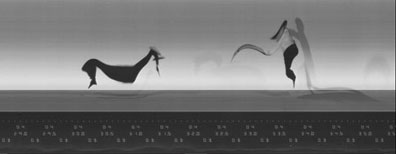
Werner Nekes mit Staubsauger, 1994
Photographie auf Aluminium aufgezogen
Sammlung Werner Nekes, Mülheim an der Ruhr
In order to be able to understand and appreciate Gábor Császári’s photographs better, it makes sense to compare them with other processes of photographic recording. Almost all cameras employ the small round hole of the camera obscura, which was adopted in variable sizes from the round opening of the iris. As long as the iris is open, the image in front of the camera is exposed together with all its movements. When something moves quickly, it will only leave a track of light on the image. The recording time or the shutter speed is dependent on the timing of the movements in front of the camera, at least if the moving object is to be reproduced clearly and without blurring. The great achievement of Eadweard Muybridge’s series photography was that he made the chemicals of the photographic film so sensitive that they could record the desired events within short exposure intervals. If the film had been less light-sensitive, any movement would merely have left a track of light on the negative, for example. Muybridge set up series of up to 24 cameras in order to be able to record the course of a movement. Étienne-Jules Marey divided up the recording time of an image by making a phenakistiscope disc with its slits rotate in front of the film negative and so facilitating multiple exposures within one image. In this way, it was possible for chronophotography to store the different positions of an object’s movement within one image. Császári chops up the picture space to be recorded through a narrow slit into brief units of time, dependent on the continually moving film and the object that moves in front of the slit. In addition to series photography and chronophotography, this is a third possibility to record the moving environment using a camera. The surprising depictions of objects in motion correspond astonishingly to images of movement – from cave painting to pictures by 20th century painters.
Gábor Császári (born 1959) lives in Hamburg.










